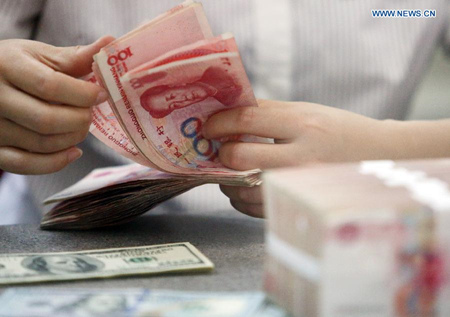
A worker counts Chinese currency Renminbi (RMB) at a bank in Linyi, east China's Shandong Province, Aug. 11, 2015. (Photo: Xinhua/Zhang Chunlei)
When China's central bank unexpectedly adjusted its yuan central parity system, it triggered the currency's biggest decline for decades.
So, what exactly happened?
On Tuesday, the People's Bank of China (PBOC) changed the way it calculated the yuan central parity rate, to close the gap between the rate and the actual trading rate on the money markets.
From Tuesday, the central parity rate has taken into account the previous day's inter-bank market closing rate, supply and demand in the market and price movements of other major currencies.
Ma Jun, a central bank economist, described the change to the way the central parity rate is calculated as a "one-off" technical correction that should not be seen as the beginning of a devaluation trend.
Just what is the central parity rate?
Each trading day at 9:15 a.m. Beijing time, the central parity rates of the yuan are announced against 11 major currencies including the euro, sterling, U.S. dollar and yen. The rates are determined by a weighted average of pre-opening prices offered by market makers. When the inter-bank FX market opens 15 minutes later, trading may only take place within 2 percent of the rate.
Why now?
The U.S. dollar is strong and a sharp appreciation in the real yuan rate has hit China's exports hard. The figures for July slumped by 8 percent. Furthermore, the central parity rate has gradually deviated from the market rate "by a large amount and for a long duration," according to the PBOC, which has undermined "the authority and the benchmark status" of the central parity system.
How did markets react?
On Wednesday, the yuan declined sharply for the second day in a row, leading to a heavy sell-off in regional currencies and raising concern worldwide that volatility will become a drag on global economic growth.
Asian stocks fell.
The yuan is expected to remain weak and volatile in the near term.


















































